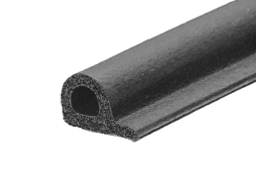Sponge Seals
Our sponge seals are ideal for various marine, automotive and industrial applications. Manufactured in a wide variety of shapes and sizes, these sections provide a solution to most sealing problems. Sponge seals are available in numerous forms, including extruded profiles or cut strip and sheet. These products serve different purposes and offer different levels of compression and recovery. All of these products are manufactured from closed-cell sponge rubber materials so will not absorb water.
Extruded profiles have an external skin and are often manufactured with a hollow centre or external fin to aid compression under minimal force. We also supply an extensive range of sponge strip cut from large sheets of sponge rubber. As these sections do not feature a central hole, they are marginally firmer than similar sized extruded profiles. Most sponge sections, extruded or cut, can be supplied with a self-adhesive backing to simplify the installation process.
As sponge seals are manufactured from soft compressible materials, we recommend that they are compressed by around 30%. For example, if you have a 10mm gap we recommend using a sponge seal that is approximately 15mm high. When compressed this will create a good watertight seal and minimise the chance of damaging the section with excessive force.
Frequently Asked Questions
What are sponge seals and what are they used for?
Sponge seals are compressible rubber profiles usually manufactured from expanded rubber materials such as EPDM, neoprene or silicone. They are designed to create an airtight and watertight seal between two surfaces. Common uses of these profiles include sealing doors, hatches, panels, enclosures and vehicle compartments where cushioning and weatherproofing are required. Their ability to compress easily makes them ideal for uneven or irregular surfaces.
What is the difference between sponge rubber and solid rubber?
Sponge rubber is softer and more compressible than solid rubber, allowing it to fill gaps more effectively and provide better cushioning. Solid rubber, on the other hand, is denser and more durable under heavy loads or where movement and abrasion are common. If you need a seal for vibration absorption or weatherproofing, sponge rubber is usually best. This compares to applications that require impact resistance or structural support, where solid rubber is usually preferable.
For more information on the differences between these materials, view our Sponge Rubber vs Solid Rubber blog post.
What is the recommended compression for a sponge seal?
Sponge seals perform best when compressed by around 30% of their original thickness. For example, if you have a 10mm gap, we recommend using a sponge seal that is around 15mm thick. This compression range ensures a tight and reliable seal without overstressing or damaging the material. Too little compression may lead to leaks or gaps, while excessive compression can cause compression set. This is permanent deformation which reduces the seals performance and lifespan.
The amount of compression required to squash a sponge profile depends on the chosen profile, material density and its length. Some of our sponge seals have a central hole that aids compression. This allows the seal to be squashed with less force.
Can sponge seals be used outdoors?
Yes, most sponge materials—particularly EPDM and neoprene—are highly resistant to weathering, UV light and ozone, making them suitable for outdoor use. They maintain flexibility in a wide range of temperatures and provide long-lasting protection against the elements.
However, although most sponge rubber profiles are suitable for outdoor environments, some profiles with a scrim tape adhesive backing should be shielded from excessive contact with water and moisture. In these situations, it would be better to use a plain sponge rubber seal with a waterproof contact adhesive.
How should sponge seals be installed?
Most sponge seals can be easily fitted using an appropriate adhesive or by pressing them into a groove or channel. Ensure the surface is clean, dry, and free from oil or dust before application for the best adhesion. Some profiles come with self-adhesive backing, which simplifies installation and eliminates the need for separate glue. Once installed, allow any adhesive to cure fully before putting the seal under compression.
Can I cut sponge seals?
Yes, sponge seals can be easily cut to length using scissors, a sharp knife or a fine-toothed blade. For a neat finish, make straight, clean cuts and avoid compressing the material while cutting. Many customers trim seals to fit custom door frames, hatches, or panels without needing specialist tools.
How long do sponge seals last?
With proper installation and maintenance, high-quality sponge seals can last for many years. Lifespan depends on exposure to sunlight, temperature changes and environmental conditions. EPDM and silicone materials generally have the longest service life due to their superior resistance to weathering and UV light.









